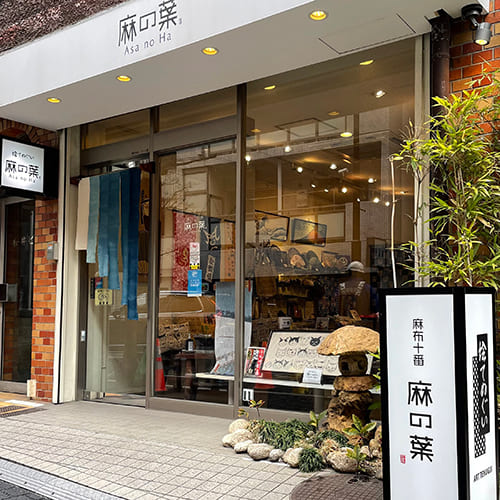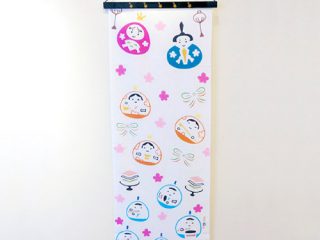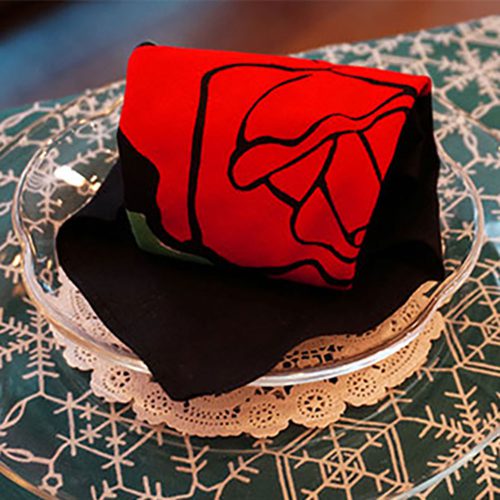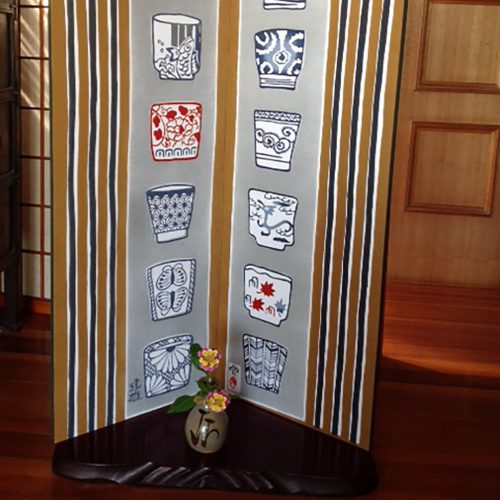Asa no ha is a Tenugui shop that conveys the essence of the Edo period to modern days.
You can find more than 1,000 original tenugui with kabuki and ukiyoe patterns, as well as other original Japanese products. You will find great souvenirs from Japan.
![]()
Minato-ku the best shop Grand Prix

Sakurai Bldg.1F 1-5-24 Azabujuban, Minato-ku,Tokyo, 106-0045 Japan
Tel: +81 3-3405-0161 Fax: +81 3-3405-7512
E-mail: info@asanoha.shop
Open 11:00-19:00 / Open throughout the year
From Azabujuban Station
Exit 7 Oedo Subway Line 5minutes walk
Exit 4 Namboku Subway Line 7minutes walk
Holiday Period: Tue., December 30, 2025 – Sat., January 3, 2026
Note: We will be open until 4:00 PM on Mon., December 29.
During the holiday period, we will continue to accept inquiries and online orders. However, please note that we will begin responding to inquiries and processing orders sequentially from Monday, January 5, 2026.












This month’s feature “Seasonal Tenugui”
We display our Tenugui in frames in the shop. We hope that you discover and enjoy the seasonal Tenugui like in a gallery.
This month at Azabujuban Asanoha, we are presenting tenugui and other Japanese goods recommended for souvenirs. We also have a variety of gift wrapping options to match your needs, such as “Happy Box,” a gift box made of tenugui, “Tatoushi,” a special package for tenugui, and gift boxes, so please visit us to find a gift.
This month’s Featured “Sharing Japanese Culture with the World”
Thoughtful Gifts with a Seasonal Touch
At AzabuJuban AsanoHa, we are hosting a special event themed “Sharing Japanese Culture with the World.” This month, we are showcasing and selling traditional Japanese handicrafts such as Awa indigo-dyed tenugui from Tokushima, Arimatsu shibori tenugui, Matsusaka cotton, and charming accessories made with vintage and indigo-dyed fabrics.
We invite you to explore and enjoy the rich beauty of Japanese culture in everyday life.

Notice of Year-End and New Year Holidays
Holiday Period: Tue., December 30, 2025 – Sat., January 3, 2026
Note: We will be open until 4:00 PM on Mon., December 29.
During the holiday period, we will continue to accept inquiries and online orders. However, please note that we will begin responding to inquiries and processing orders sequentially from Monday, January 5, 2026.

[Order from Just One Piece] Personalized Tenugui, Handkerchiefs, and Furoshiki
At AzabuJuban Asa no Ha, we offer personalized printing on tenugui, handkerchiefs, furoshiki, baby jinbei, and more. You can order from just one piece with your name, message, or logo. Perfect as a unique Japanese souvenir or a special gift for birthdays, weddings, new births, milestone celebrations, or as commemorative items for businesses, stores, or events. Each item is carefully crafted by skilled craftsmen.
[New Arrival] Plain-Dyed Tenugui – New Shades Added
December 24, 2025
New colors have been added to our plain-dyed tenugui collection.
While retaining the gentle texture unique to sarashi cotton, the lineup now offers a total of nine colors to choose from, suited to different moods and uses.
We invite you to discover the new colors in our shop.
[New Arrival] Zodiac Tenugui :The Divine Horse Soaring to the Sky
November 04, 2025
Our popular annual zodiac tenugui is now available, beautifully dyed and ready for the New Year. It makes a thoughtful and traditional gift for seasonal greetings and New Year’s celebrations.
Please note: Limited quantities available. We recommend placing your order early.
What is TENUGUI
Tenugui is unique Japanese hand dyed cotton cloth and has a long history dating from 8th century. Japanese people use Tenugui in daily life. It can be used as hand towel, home decoration, wrapping cloth, scarf, sewing textile, etc.
Art Tenugui is made by expert craftsmen using traditional techniques. All the process such as pattern cutting, pattern setting, color blocking and dyeing are done by hand. No single Tenugui is the same because of this manual craft technique.
We hope you enjoy bright colors and chic textures of our Tenugui as well as stories of Japanese culture told by Tenugui.
HOW TO USE TENUGUI
WIPE
Tenugui, as its name suggests, has been used for wiping water and sweat for centuries. The sun-dried bleached cotton “sarashi-momen” is used for dyeing, so the fabric of the Tenugui feels the warmth of the sun and becomes softer the more it is used. Also, the material is highly breathable and quick-drying, so it dries quickly.
WEAR
It is said that in the Edo period, people changed the way they wore Tenugui depending on their occupation or occasion to get into the spirit and enjoy fashion. Today, Tenugui is used for kendo (fencing) and traditional festivals “matsuri”, but it can also be incorporated into fashion as a hair band or turban by arranging the pattern and the way it is worn.
ROLL
In the Edo period, when people were injured on the road, they would quickly wrap a Tenugui around themselves and use it as a bandage. If you wrap it around your neck, it will protect you from the cold, if the sun is strong, it will protect you from the sun and stop you from sweating, if you wear a kimono, it can be used as a neckpiece “haneri”, and if you put a string around the Tenugui, it can be used as an apron. Wrapping a Tenugui can be used as a hygiene item.
PLACE
Plain weave Tenugui is easy to clean and can be washed easily, so it is also useful as tableware. If you lay out Tenugui according to the season or theme and use it as a table runner or luncheon mat. If you lay it as a mat under a vase of flowers, it will protect them from your precious furniture.
COVER
Just place a Tenugui on your computer or bag to keep the dust away. Wrap it around your child’s neck and it becomes an apron to protect them from food stains. And just by folding the Tenugui and threading the elastic, you have an instant Tenugui mask! Covering the Tenugui will protect you from dirt and viruses.
WRAP
Tenugui can also be used as a wrapping material like “furoshiki”. Since it is made of 100% cotton, it is strong enough to be folded and tied. After the gift is given, it can of course be used as a Tenugui, making it an ecological item. It is also convenient for wrapping a lunch box or a bottle to carry around.
DECORATE
Today, one of the most popular ways to use Tenugui is to display it as interior decoration. Set it in a frame or on a tapestry, and your Tenugui becomes an art. Just by displaying Tenugui, you can enjoy Japanese culture.
SEW
In recent years, “Tenugui remake” has been gaining attention. The reason why Tenugui is so popular as a material for handmade items is that it comes in a wide variety of beautiful and fashionable patterns, and its 100% cotton bleached cotton “sarashi-momen” is safe to use for people with delicate skin and babies. Also, the long side of the Tenugui is the hem of the fabric, so it can be used without sewing. Why don’t you try making your own one-of-a-kind accessories with your favorite Tenugui?
We have over 1,000 Tenugui and Tenugui items.
Why is the short side of the Tenugui not sewn?
The short side of the Tenugui is not sewn.
The reason for this is that there is no folded part to keep it clean and dust-free, and also to dry it quickly. When you start using a new Tenugui, it may fray around the edges, but after washing it a few times, fraying will stop.



Sakurai Bldg.1F 1-5-24 Azabujuban, Minato-ku,Tokyo,106-0045 Japan
Tel: +81 3-3405-0161 Fax: +81 3-3405-7512
Email: info@asanoha.shop
Open 11:00-19:00 / Open throughout the year
From Azabujuban Station
Exit 7 Oedo Subway Line 5minutes walk
Exit 4 Namboku Subway Line 7minutes walk





















































